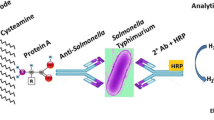Abstract
A self-assembled monolayer of protein G was fabricated to develop an immunosensor based on surface plasmon resonance (SPR), thereby improving the performance of the antibody-based biosensor through immobilizing the antibody molecules (IgG). As such, 11-mercaptoundecanoic acid (11-MUA) was adsorbed on a gold (Au) support, while the non-reactive hydrophilic surface was changed through substituting the carboxylic acid group (-COOH) in the 11-MUA molecule using 1-ethyl-3-(3-dimethylaminopropyl) carbodiimide hydrocholide (EDAC). The formation of the self-assembled protein G layer on the Au substrate and binding of the antibody and antigen were investigated using SPR spectroscopy, while the surface topographies of the fabricated thin films were analyzed using atomic force microscopy (AFM). A fabricated monoclonal antibody (Mab) layer was applied for detectingE. coli O157∶H7. As a result, a linear relationship was achieved between the pathogen concentration and the SPR angle shift, plus the detection limit was enhanced up to 102 CFU/mL.
Similar content being viewed by others

References
Kricka L. J. (2001) Microchips, microarrays, biochips and nanochips: personal laboratories for the 21st century.Clin. Chim. Acta 307: 219–223.
Borrebaeck, C. A. K. (2000) Antibodies in diagnostics-from immunoassays to protein chips.Rev. Immunol. Today 21: 379–382.
Kurdowska A., E. J. Miller, A. Krupa, J. M. Noble, and Y. Sakao (2002) Monoclonal antibodies to rabbit a-2-macroglobulin and their use in a sensitive ELISA assay.J. Immunol. Methods 270: 147–153.
Kim, J. W., L. Z. **, S. H. Cho, R. R. Marquardat, A. A. Frohlich, and S. K. Baidoo (1999) Use of chicken egg-yolk antibodies against K88+fimbral antigen for quantitative analysis of enterotoxigenicEscherichia coli (ETEC) K88 by a sandwich ELSIA.J. Sci. Food Agric. 79: 1513–1518.
Chudinova, G. K., A. V. Chudinov, V. V. Savransky, and A. M. Prokhorov (1997) The study of the antigen-antibody reaction by fluorescence method in LB films for immunosensor.Thin Solid Films 307: 294–297.
Feng C.-L., Y.-H. Xu, and L.-M. Song (2000) Study on highly sensitive potentiometric IgG immunosensor.Sens. Actuat. B 66: 190–192.
Darren, M. D., C. C. David, H.-X. You, and R. L. Christopher (1998) Covalent coupling of immunoglobulin G to self-assembled monolayers as a method for immobilizing the interfacial recognition layer of a surface plasmon resonance immunosensor.Biosens. Bioelectron. 13: 1213–1225.
Breen, T. L., J. Tien, S. R. J. Oliver, T. Hadzic, and G. M. Whitesides (1999) Design and self-assembly of open regular 3D mesostructure.Science 284: 948–951.
Choi, H. G., J. Min, W. H. Lee, and J.-W. Choi (2002) Adsorption behavior and photoelectric response characteristics of bacteriorhodpsin thin films fabricated by self-assembly technique.Colloids Surf. B 23: 327–337.
Ferretti, S., S. Paynter, D. A. Russel, K. E. Sapsford, and D. J. Richardson. (2000) Self-assembled monolayers; a versatile tool for the formation of bio-surfaces.Trends Analytical Chemistry, 19: 530–540.
Boyle, M. D. P. and Reis, K. J. (1987). Bacterial Fc receptors.Biotechnol. 5: 697–703.
Toyama, S., Shoji, A., Yoshida, Y., Yamauchi, S., and Ikariyama, Y. (1998) Surface design of SPR-based immunosensor for the effective binding of antigen or antibody in the evanescent field using mixed polymer matrix.Sens. Actuat. B 52: 65–71.
Pearson, C., J. Nagel, and M. C. Petty. (2001) Metal ion sensing using ultrathin organic films prepared by the layer-by-layer adsorption technique.J. Phys. D: Appl. Phys 34: 1–7.
Lanteri, N., R. Rolandi, P. Cavatorta, E. Polverini, P. Riccio, and A. Gliozzi (2000) Myelin Basic Protein-Lipid Complex: an Atomic force microscopy study.Colloids Surf. A 175: 3–9.
Jones, D. L. (1999) Potential health risks associated with the persistence ofE. coli O157 in agricultural environments.Soil Use Manage. 15: 76–83.
Liddell, K. G. (1997)Escherichia coli O157: outbreak in central Scotland.Lancet 349: 502–503.
Willshaw, G. A., J. Thirlwell, A. P. Jones, S. Parry, R. L. Salmon, and M. Hickey (1994) Verocytotoxin-producingEscherichia coli O157 in beefburgers linked to an outbreak of diarrhea, haemorrhagic colitis and haemolytic uraemic syndrome in Britain.Appl. Microbiol. 19: 304–307.
Oh, B.-K., Y.-K. Kim, Y.-M. Bae, W. H. Lee, and J.-W. Choi (2002) Detection ofEscherichia coli O157∶H7 using immunosensor based on surface plasmon resonance.J. Microbiol. Biotechnol. 12: 780–786.
Yam, C. M., L. Zheng, M. Salmain, C. M. Pradier, P. Marcus, and G. Jaouen, (2001) Labelling and binding of poly-(L-lysine) to functionalized gold surface. Combined FT-IRRAS and XPS characterization.Colloids Surf. B 21: 317–327.
Harke, M., R. Teppner, O. M. Schulz, and H. Orendi (1997) Description of a single modular optical setup for ellipsometry, surface plasmons, waveguide modes, and their corresponding imaging technique including Brewster angle microscopy.Rev. Sci. Instrum. 68: 3130–3134.
Kretschmann, E. (1971) Die bestimmung optischer konstanten von metallen durch anregung von oberflachen-plasmaschwingungen.Z. Phys. 241: 313–324.
Salmon, Z., H. A. Macleod, and G. Tollin (1997) Surface plasmon resonance spectroscopy as a tool for investigating the biochemical and biophysical properties of membrane protein systems. II. Applications to biological systems.Biochim. Biophys. Acta 1331: 131–152.
Nelles, G., H. Schönherr, M. Jaschke, H. Wolf, M. Schaub, J. Küther, W. Tremel, E. Bamberg, H. Ringsdorf, and H. Butt (1998) Two-dimensional structure of disulfides and thiols on gold(111).Langmuir 14: 808–815.
Author information
Authors and Affiliations
Corresponding author
Rights and permissions
About this article
Cite this article
Oh, BK., Lee, W., Lee, W.H. et al. Nano-scale probe fabrication using self-assembly technique and application to detection ofEscherichia coli O 157∶H7. Biotechnol. Bioprocess Eng. 8, 227–232 (2003). https://doi.org/10.1007/BF02942270
Received:
Accepted:
Issue Date:
DOI: https://doi.org/10.1007/BF02942270



